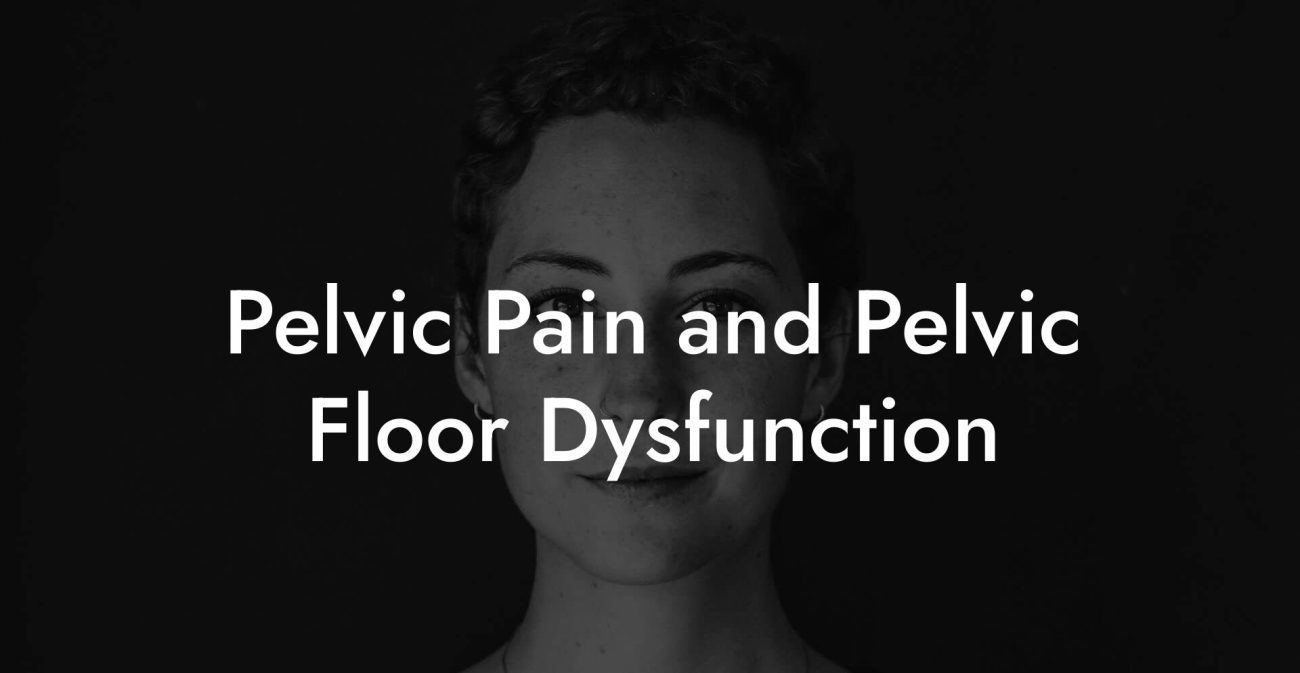
Pelvic Floor Therapy
Integrative and Holistic Approaches To Pelvic Floor Therapy

Picture your pelvic floor as the ultimate multitasker, a dynamic powerhouse ready to groove with holistic healing vibes. In a world where wellness isn’t just about sweating it out at the gym or counting calories, integrative and holistic pelvic floor therapy offers a revolutionary overhaul. This isn’t your grandma’s pelvic exercise routine; it’s an all-encompassing journey that meshes traditional physical therapy with complementary treatments, mindful practices, and lifestyle tweaks. Whether you’re navigating chronic pelvic pain, fine-tuning muscle coordination, or simply leveling up your core health, get ready for an immersive adventure toward a thriving, empowered you.
Quick Links to Useful Sections
- Understanding Integrative and Holistic Pelvic Floor Therapy
- The Pillars of Holistic Pelvic Floor Therapy
- Conventional Therapies: The Groundwork of Pelvic Health
- Pelvic Floor Physical Therapy
- Manual Therapy and Myofascial Release
- Biofeedback and Electrical Stimulation
- Complementary and Alternative Therapies: Embracing Natural Wisdom
- Acupuncture
- Chiropractic Adjustments
- Massage Therapy and Myofascial Techniques
- Herbal Remedies and Nutritional Supplements
- Mind-Body Practices: Amplifying Your Inner Strength
- Mindfulness Meditation
- Deep Breathing Techniques
- Yoga and Pilates
- Nutrition and Lifestyle: Fueling Your Pelvic Health Revolution
- Adopting an Anti-Inflammatory Diet
- Hydration and Lean Protein
- Active Living and Consistent Movement
- Quality Sleep and Stress Management
- Real-Life Transformations: Integrative Case Studies
- Case Study 1: Maria’s Journey from Chronic Pain to Empowered Wellness
- Case Study 2: John’s Post-Surgical Revival
- Case Study 3: David’s Breakthrough Over Stress-Induced Dysfunction
- Crafting Your Personalized Integrative Pelvic Floor Therapy Plan
- Step 1: Conduct a Comprehensive Assessment
- Step 2: Set Clear, Achievable Goals
- Step 3: Mix and Match Therapeutic Modalities
- Step 4: Establish a Daily Routine
- Step 5: Monitor, Evaluate, and Adjust
- Integrative and Holistic Approaches FAQs: Your Questions Answered
- Resources and Community Support: Your Next Steps
- Your Journey to Empowered, Holistic Pelvic Health
Understanding Integrative and Holistic Pelvic Floor Therapy
Integrative pelvic floor therapy steps away from a “one-size-fits-all” approach. Instead, it’s a vibrant combination of conventional medical strategies and natural, holistic interventions. In the past, pelvic floor therapy might have meant countless boring sets of Kegels and endless pelvic exercises. But today, therapy is a full-spectrum experience, bridging clinical expertise with practices like yoga, acupuncture, mindful breathing, dietary interventions, and lifestyle designs.
At its core, integrative and holistic pelvic floor therapy acknowledges that your body is an interconnected ecosystem. When one part of your system, like your pelvic floor, suffers, it can create a chain reaction affecting your mental, physical, and emotional health. By addressing everything from muscle tension and inflammation to stress and nutrition, you create an environment where healing isn’t just possible; it’s inevitable.
For Gen Z and millennials who demand authenticity, flexibility, and innovation in every aspect of life, this method offers a refreshing embrace of modern science fused with time-honored natural practices. The result? A customized healing pathway that speaks to the rhythms of your body.
The Pillars of Holistic Pelvic Floor Therapy
Think of your pelvic health as a balance beam that thrives on equilibrium. To master this balance, holistic pelvic floor therapy rests on five core pillars:
- Conventional Medical Treatments: These include pelvic floor physical therapy, manual mobilization techniques, biofeedback sessions, and, when needed, medications or minimally invasive procedures.
- Complementary Therapies: Incorporate methods such as acupuncture, chiropractic adjustments, massage, and energy healing to alleviate pain and improve muscle functionality.
- Mind-Body Techniques: Practices like mindfulness meditation, deep breathing, yoga, and Pilates fortify the connection between your physical body and emotional well-being, easing muscle tension and chronic stress.
- Nutritional Support: Eating a balanced diet filled with anti-inflammatory foods, lean proteins, and vibrant superfoods supports muscle repair and overall pelvic floor resilience.
- Lifestyle Adjustments: Regular movement, proper sleep, stress management, and even posture correction are the unsung heroes of a well-rounded pelvic floor regimen.
When these pillars support your pelvic health, they create a synergistic effect that is far more potent than isolated exercises. It’s about building radical, sustainable wellness from every angle.
Conventional Therapies: The Groundwork of Pelvic Health
The starting point of every robust pelvic floor strategy is conventional therapy. This is where the science of movement and anatomy meets personalized care:
Pelvic Floor Physical Therapy
In a clinical setting, pelvic floor physical therapy offers a comprehensive evaluation of your muscle strength, coordination, and tension. Using rigorous assessments, often including manual palpation and biofeedback, specialists tailor exercises that specifically target problem areas. The classic Kegel exercises are just one gem in a treasure trove of tailored movements aimed at restoring function.
Manual Therapy and Myofascial Release
Manual techniques such as myofascial release, trigger point therapy, and soft-tissue mobilization aim to liberate areas of tension, boost circulation, and reduce pain. These hands-on methodologies are especially effective for those who have endured chronic pain or surgical recovery. The symbolic “touch” of a skilled therapist is sometimes exactly what your body craves, an empathic reset.
Biofeedback and Electrical Stimulation
Biofeedback stands out as a technological ally in pelvic therapy. With real-time visual or auditory signals, you learn to control muscle contractions effectively. This feedback-loop mechanism not only improves exercise techniques but also accelerates your recovery, letting you understand your body’s responses in real time.
Together, these conventional therapies lay the foundation for your pelvic floor to regain strength, functionality, and harmony.
Complementary and Alternative Therapies: Embracing Natural Wisdom
While clinical treatments address the physical mechanisms, complementary therapies tap into time-tested methods that soothe, heal, and rejuvenate, all naturally. Here’s how some favorite alternatives play a role:
Acupuncture
Acupuncture, an ancient Chinese practice, uses fine needles to stimulate key points in the body. For pelvic floor issues, acupuncture can reduce chronic pain, ease muscle tightness, and even promote better circulation in the region. Many people report feeling a profound sense of relaxation and a rebalanced energy flow after an acupuncture session.
Chiropractic Adjustments
A misaligned spine or pelvis can put undue stress on the pelvic floor muscles. Chiropractic care focuses on such misalignments, using precise adjustments to restore balance and alleviate nerve pressure. This not only relieves localized discomfort but also boosts overall muscle coordination and function.
Massage Therapy and Myofascial Techniques
Massage therapy, including deep tissue and myofascial release, helps break down adhesions and tension in the pelvic region. Regular sessions can lead to a measurable decrease in muscle knots and chronic pain, making each day a bit lighter and more fluid.
Herbal Remedies and Nutritional Supplements
Certain herbal supplements, such as turmeric, ginger, and omega-3 fatty acids, play a supportive role by reducing inflammation and promoting tissue repair. Incorporating natural anti-inflammatories and antioxidants from whole foods can optimize healing from the inside out. Always have a chat with your healthcare provider before starting any supplements to ensure they mesh well with your overall plan.
By blending these holistic methods with mainstream physical therapy, you create a multi-layered approach that targets both the immediate symptoms and the underlying causes of pelvic floor dysfunction.
Mind-Body Practices: Amplifying Your Inner Strength
Modern wellness celebrates the profound connection between the mind and body. When it comes to pelvic health, stress isn’t just in your head, it can manifest as muscle tension that worsens symptoms. Incorporating mind-body practices ensures that you tackle both the emotional and physical challenges head-on.
Mindfulness Meditation
Mindfulness meditation is your secret weapon for unwinding the web of stress that often entangles your muscles. A few minutes of focused breathing and present-moment awareness can lower cortisol levels and help you achieve a state of profound relaxation, thus easing the tension in your pelvic floor.
Deep Breathing Techniques
There’s power in every breath. Techniques like diaphragmatic breathing naturally complement pelvic floor exercises, teaching you how to synchronize muscle contractions with calm, flowing breath patterns. These simple practices cultivate a mind-body connection that improves overall muscle control and encourages deep relaxation.
Yoga and Pilates
Yoga and Pilates are more than trendy workout choices, they’re incredibly effective at strengthening your core while gently activating your pelvic floor. From the graceful flow of yoga’s vinyasa sequences to the precision of Pilates reformer lessons, each movement enhances flexibility, stability, and control. Popular yoga poses such as the child's pose, cat-cow, and bridge serve to release tension and encourage a healthy pelvic alignment.
Embracing a regular mind-body routine doesn’t just relieve stress, it empowers you to re-engage with your body in a way that’s both fun and transformative. Over time, these practices become second nature, ingraining a sense of calm and balance that radiates throughout your entire well-being.
Nutrition and Lifestyle: Fueling Your Pelvic Health Revolution
While exercise and therapy are pivotal, what you eat and how you live are equally critical in the journey to holistic pelvic health. Think of your body as a high-performance machine, its fuel must be top-notch for peak performance.
Adopting an Anti-Inflammatory Diet
A diet that champions whole, unprocessed foods works wonders for reducing inflammation in the body. Load up on vibrant fruits, leafy greens, nuts, and whole grains, all of which not only nourish your brain and body but also specifically support muscle repair and reduce inflammation. Foods like blueberries, spinach, quinoa, and salmon are your go-to allies in this quest.
Hydration and Lean Protein
Staying hydrated is non-negotiable. Water is the medium through which your body fuels every biochemical reaction, including muscle repair. Pair hydration with lean proteins from chicken, fish, legumes, or tofu to ensure your muscles have the essential building blocks necessary for recovery and strength.
Active Living and Consistent Movement
Incorporating low-impact activities such as walking, swimming, or gentle cycling into your daily routine helps maintain muscle flexibility and boosts overall circulation. While targeted pelvic exercises are critical, regular movement keeps your body agile and prevents stagnation.
Quality Sleep and Stress Management
Sleep isn’t just downtime, it’s prime time for healing. Aim for 7-9 hours of restorative sleep every night. Alongside a good sleep routine, finding effective strategies for stress management (such as mindfulness or progressive muscle relaxation) ensures that your body remains in a balanced state, free from excessive tension or fatigue.
Together, these nutritional choices and lifestyle tweaks create a fertile ground for your pelvic floor to heal and thrive. They aren’t a quick fix, they’re an ongoing commitment to nurturing every part of your well-being.
Real-Life Transformations: Integrative Case Studies
There’s nothing quite as inspiring as hearing the stories of those who have experienced a full-circle transformation using integrative pelvic floor therapy. Here are a few real-life journeys that highlight the profound impact of these holistic methods:
Case Study 1: Maria’s Journey from Chronic Pain to Empowered Wellness
Maria had long struggled with chronic pelvic pain and incontinence, conditions that made even daily activities a challenge. After months of feeling stuck, she decided to try a holistic approach. By dedicating herself to an integrative regimen combining pelvic floor physical therapy, acupuncture sessions, guided mindfulness meditations, and a nutrient-dense anti-inflammatory diet, Maria noticed gradual yet dramatic improvements. Her pain diminished, her bladder control improved, and perhaps most importantly, she discovered a renewed sense of empowerment. Maria’s story underscores that holistic healing isn’t just about symptom relief, it’s about reclaiming control over your life.
Case Study 2: John’s Post-Surgical Revival
John, a 55-year-old gentleman recovering from pelvic organ prolapse surgery, experienced significant setbacks post-operation. His recovery plan was as much about rebuilding confidence as it was about physical rehabilitation. By integrating customized pelvic floor exercises with supportive measures such as yoga, nutritional counseling, and biofeedback monitoring, John observed a rapid improvement in core stability and a notable reduction in incontinence. The fusion of conventional rehabilitation techniques with integrative practices not only sped up his recovery but also helped him embrace a new, more active lifestyle.
Case Study 3: David’s Breakthrough Over Stress-Induced Dysfunction
In the high-pressure world of corporate leadership, David, aged 47, found himself entangled in a vicious cycle of stress and pelvic floor tension. The chronic anxiety from his workload was directly exacerbating his urinary leakage and pelvic discomfort. Determined to break the cycle, David turned to integrative therapy. By embedding daily mindfulness sessions, deep breathing exercises, regular pelvic workouts, and natural anti-inflammatory foods into his lifestyle, he gradually eased the tension that had long plagued him. Over time, not only did his pelvic pain subside, but his overall mental clarity improved, enabling him to perform better both at work and in life.
These stories illustrate that an integrative, holistic approach isn’t reserved for a select few. Whether you’re grappling with persistent pain, recovering from surgery, or simply aiming to optimize your pelvic health, an all-inclusive, thoughtful regimen can open doors to remarkable transformations.
Crafting Your Personalized Integrative Pelvic Floor Therapy Plan
The journey to empowered pelvic health is uniquely yours. Crafting a personalized therapy plan that adapts to your specific challenges and lifestyle can set you on a clear path toward lasting healing. Here’s how to design your custom plan:
Step 1: Conduct a Comprehensive Assessment
Begin with an in-depth evaluation from a pelvic floor specialist. This examination should extend beyond basic muscle testing to include your lifestyle, dietary patterns, stress levels, and even mental health. By identifying the root causes of your pelvic dysfunction, you and your provider can outline effective strategies tailored to you.
Step 2: Set Clear, Achievable Goals
Define what success looks like for you. Your goals might range from reducing pelvic pain and improving incontinence to enhancing core stability or boosting overall vitality. Writing your goals down, measurable and realistic, can keep you motivated and help you track your progress over time.
Step 3: Mix and Match Therapeutic Modalities
The beauty of integrative therapy lies in its flexibility. Create a balanced schedule by blending:
- Customized pelvic floor exercises (including Kegels, reverse Kegels, and core strengthening movements).
- Complementary therapies such as acupuncture, chiropractic adjustments, or specialized massage sessions.
- Mind-body practices like daily mindfulness meditation, deep breathing exercises, and yoga flows.
- Nutritional interventions by incorporating an anti-inflammatory diet rich in antioxidants and lean proteins.
- Technological aids like biofeedback devices or mobile apps designed to monitor your progress.
Step 4: Establish a Daily Routine
Consistency is the secret sauce. Build your day to include a mix of exercise, mindfulness, hydration, and rest. Whether it’s a morning mindfulness session followed by a quick set of pelvic exercises or a post-work yoga flow, sticking to a routine ensures you’re actively nurturing your health every day.
Step 5: Monitor, Evaluate, and Adjust
Your energy, progress, and even your mood are signals guiding your healing journey. Keep a journal tracking your activities, symptoms, and any improvements you notice. Regular consultations with your healthcare provider can help tweak your program as your needs evolve, ensuring that your method remains dynamic, effective, and reflective of your progress.
With personalization at the heart of your plan, every modification, from tweaking your diet to introducing new therapy sessions, empowers your body and mind to sustain long-term pelvic health.
Integrative and Holistic Approaches FAQs: Your Questions Answered
We know you might have a lot of questions, so here’s a curated FAQ section addressing the most common inquiries about integrative and holistic pelvic floor therapy:
1. What does “integrative and holistic” pelvic floor therapy mean?
It means blending conventional physical therapy with complementary methods like acupuncture, massage, mind-body practices, and nutritional interventions to create a comprehensive, all-inclusive treatment plan.
2. How do integrative approaches differ from traditional pelvic floor therapy?
Traditional approaches often rely solely on exercises and manual techniques, whereas integrative methods consider the full scope of physical, emotional, and nutritional factors to promote overall well-being.
3. Can holistic therapies really make a difference in pelvic floor dysfunction?
Absolutely. Holistic practices such as mindfulness, yoga, acupuncture, and a balanced diet have helped many individuals markedly reduce pain and enhance muscle function.
4. How important is the mind-body connection in these therapies?
The mind-body connection is fundamental; stress and anxiety can intensify muscle tension, so integrating mindfulness and relaxation techniques can significantly improve outcomes.
5. What role does nutrition play in pelvic floor health?
Proper nutrition repairs and strengthens muscles, reduces inflammation, and powers recovery. A diet rich in anti-inflammatory foods and lean proteins supports long-term pelvic health.
6. Are biofeedback devices used in integrative pelvic floor therapy?
Yes. Biofeedback technology provides real-time insight into your muscle activity, helping you adjust your exercises, enhance focus, and track progress effectively.
7. Can integrative therapies help with chronic pelvic pain?
Yes, many patients report significant relief from chronic pelvic pain when combining standard physical therapy with therapies like acupuncture, massage, and mindfulness.
8. How do I know if an integrative approach is right for me?
Consult a pelvic floor specialist who can assess your condition comprehensively and recommend a personalized plan that incorporates integrative therapies.
9. Is there evidence to support the effectiveness of holistic pelvic floor therapy?
Emerging clinical research and patient experiences continue to endorse a holistic approach, highlighting benefits such as improved muscle function, reduced pain, and better overall quality of life.
10. Can I implement integrative therapies at home?
Many techniques, such as mindfulness exercises, yoga, and dietary improvements, are easily implemented at home, while more specialized treatments might require guidance from professionals.
Resources and Community Support: Your Next Steps
When embarking on this journey to empowered pelvic health, remember that you’re not alone. There’s a vibrant community of professionals, online forums, support groups, and wellness apps tailored specifically to pelvic floor therapy enthusiasts. Whether you’re seeking a local pelvic health specialist, curious about the latest research, or excited to join an online community of peers, the resources available can help guide and inspire you every step of the way.
Explore websites dedicated to pelvic health, follow social media influencers who specialize in integrative wellness, and don't be afraid to ask questions. From virtual consultations to hands-on workshops, the digital age makes it easier than ever to find support and cut through the noise. Connect with communities that match your vibe, ones that embrace holistic healing, share real-life success stories, and celebrate every win, big or small.
Investing time in community support not only enriches your knowledge but also provides the emotional encouragement needed to sustain your journey. In a world where authentic connection matters, leveraging these resources can be the catalyst for sustained success on your path to holistic pelvic health.
Your Journey to Empowered, Holistic Pelvic Health
Embracing integrative and holistic pelvic floor therapy is not just a treatment, it’s a movement toward reclaiming your body and mind. Every mindful breath, every nourishing meal, and every personalized exercise is a step toward unlocking your full potential.
As you blend conventional therapies with alternative practices, you’re not only addressing the symptoms but also nurturing a deeper understanding of your body’s intricate wisdom. This journey is about empowerment, about feeling confident in your body’s ability to heal and thrive, even when life gets unpredictable.
Dive into this paradigm of healing with hesitance tossed aside; trust that each integrative modality contributes to a stronger, more resilient pelvic floor. Your commitment to a balanced lifestyle, one that honors both the scientific and the soulful, creates a foundation where every part of you can flourish.
Whether you are just starting or are well on your way to a holistic health revolution, remember: the future of your pelvic health is in your hands. Lean into the process, celebrate the small victories, and let every step be a reminder of the incredible power you hold. The journey is demanding but rewarding, a testament to the incredible potential of integrative healing.
Now is the moment to champion your pelvic health. Trust the process, embody the change, and stride forward into a future where every cell sings with vitality. Embrace the dynamic synergy of science and soul, and let your healing story inspire others. Your journey to holistic pelvic health isn’t just about recovery, it’s about transformation, empowerment, and a radical reimagining of what it means to live well.
Curious About Your Pelvic Floor? Explore our curated collection of insightful articles to learn more and take charge of your health.
- Pelvic Floor Basics
- Pelvic Floor Exercises & Workouts
- Pelvic Floor Kegel Exercises: Techniques & Benefits
- Advanced Pelvic Floor Workouts
- Pre/Post-Natal Pelvic Floor Routines
- Pelvic Floor Exercises for Men
- Pelvic Floor Therapy Techniques
- At-home vs Professional Pelvic Floor Therapy Options
- Diet & Lifestyle for a Healthy Pelvic Floor
- Pelvic Floor Health & Wellness
- Specialized Pelvic Floor Conditions & Treatments
Now back to the main article!






